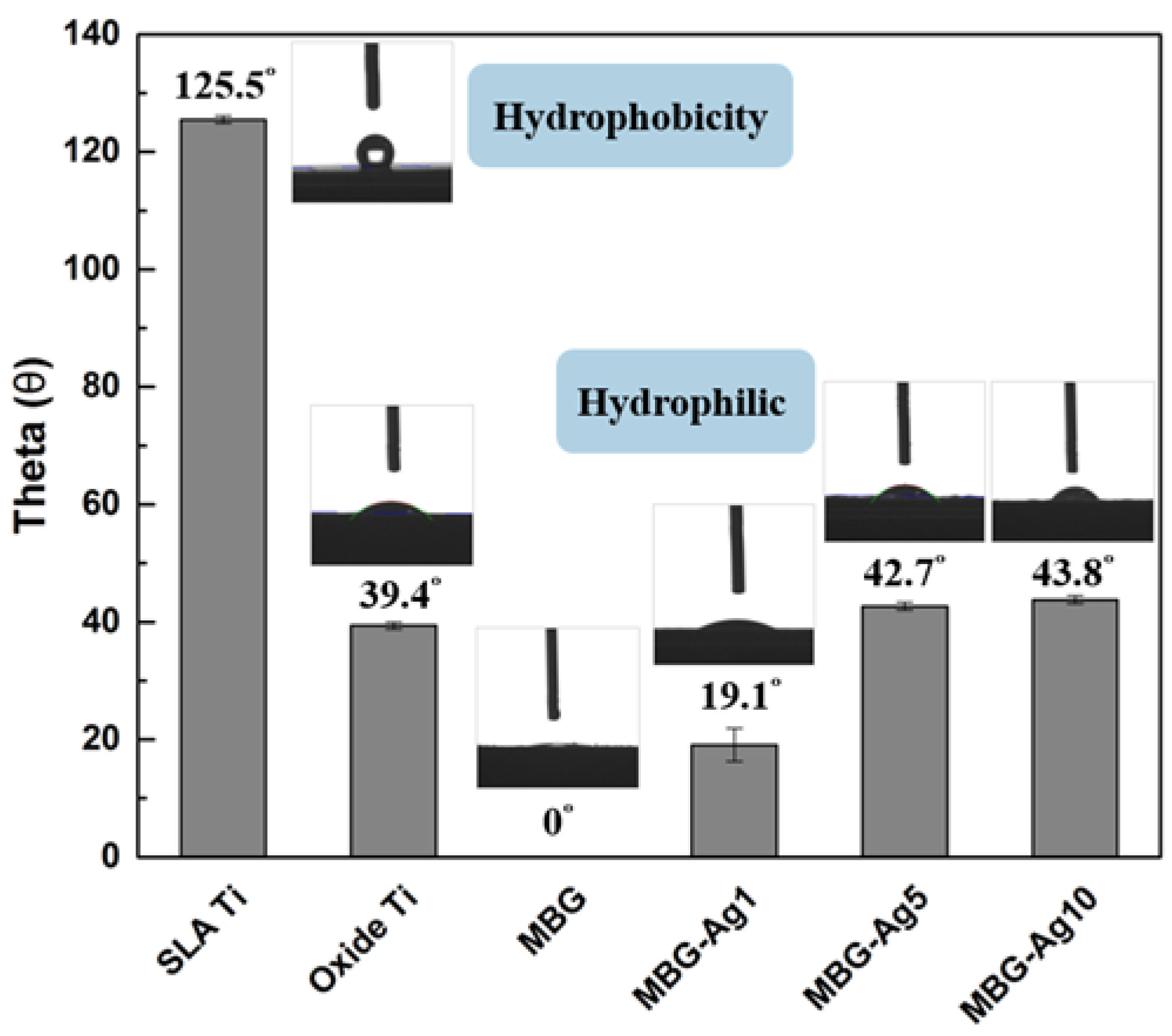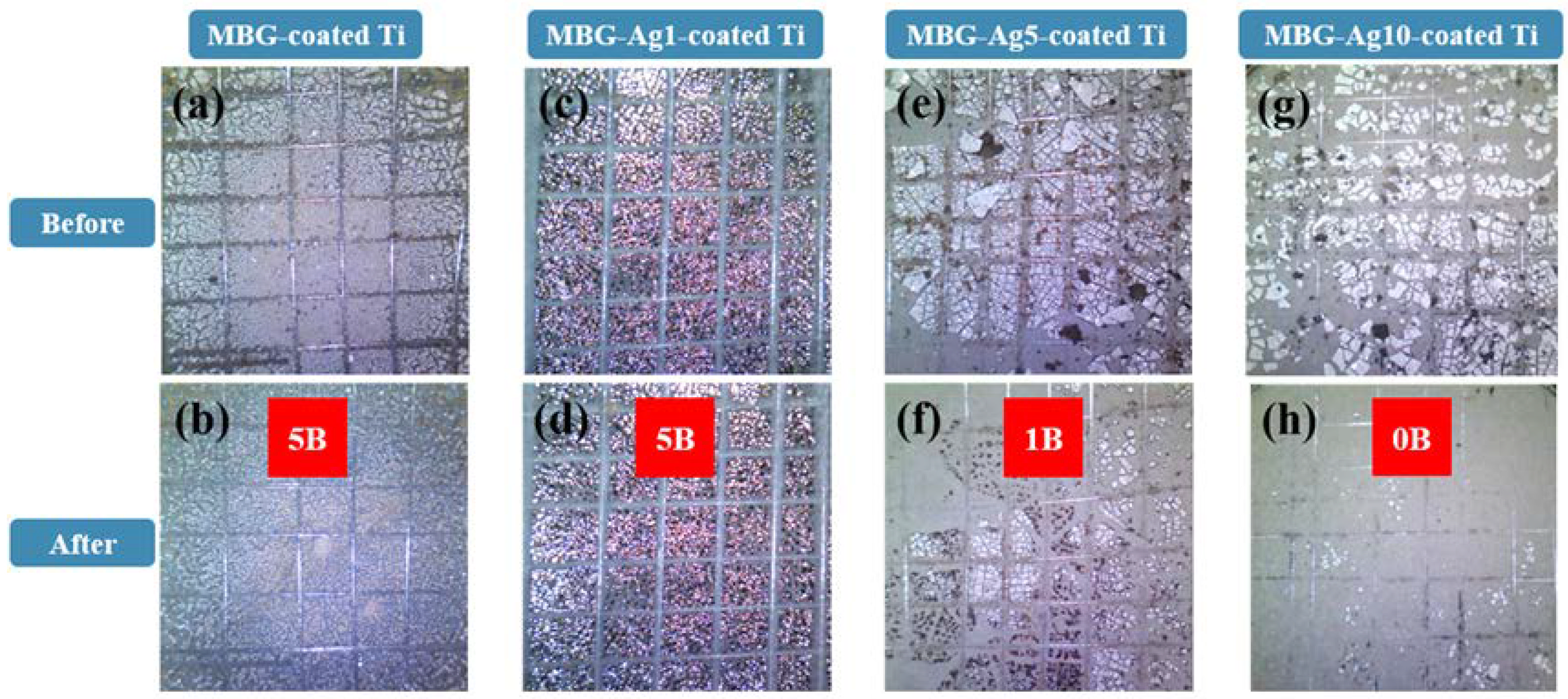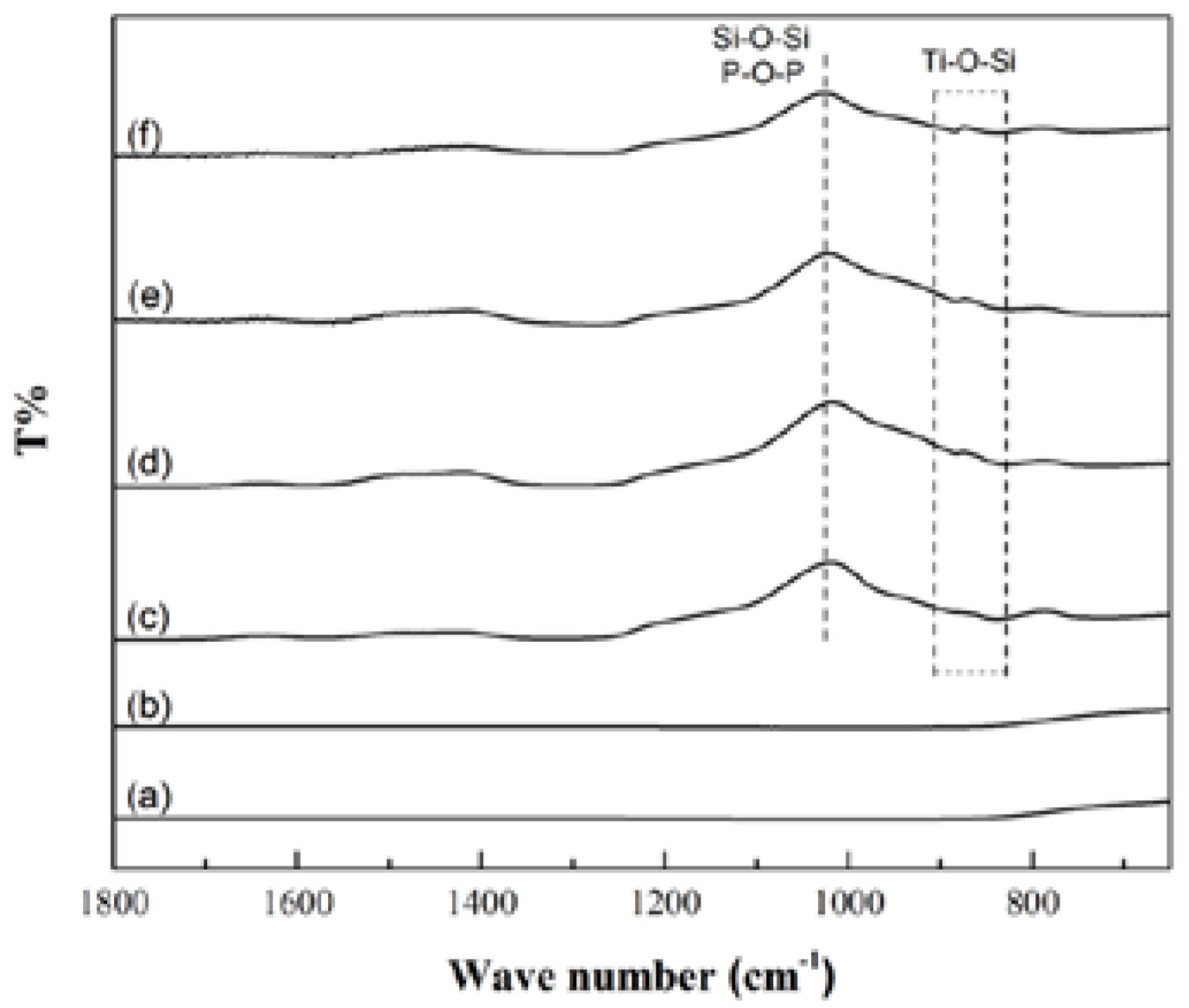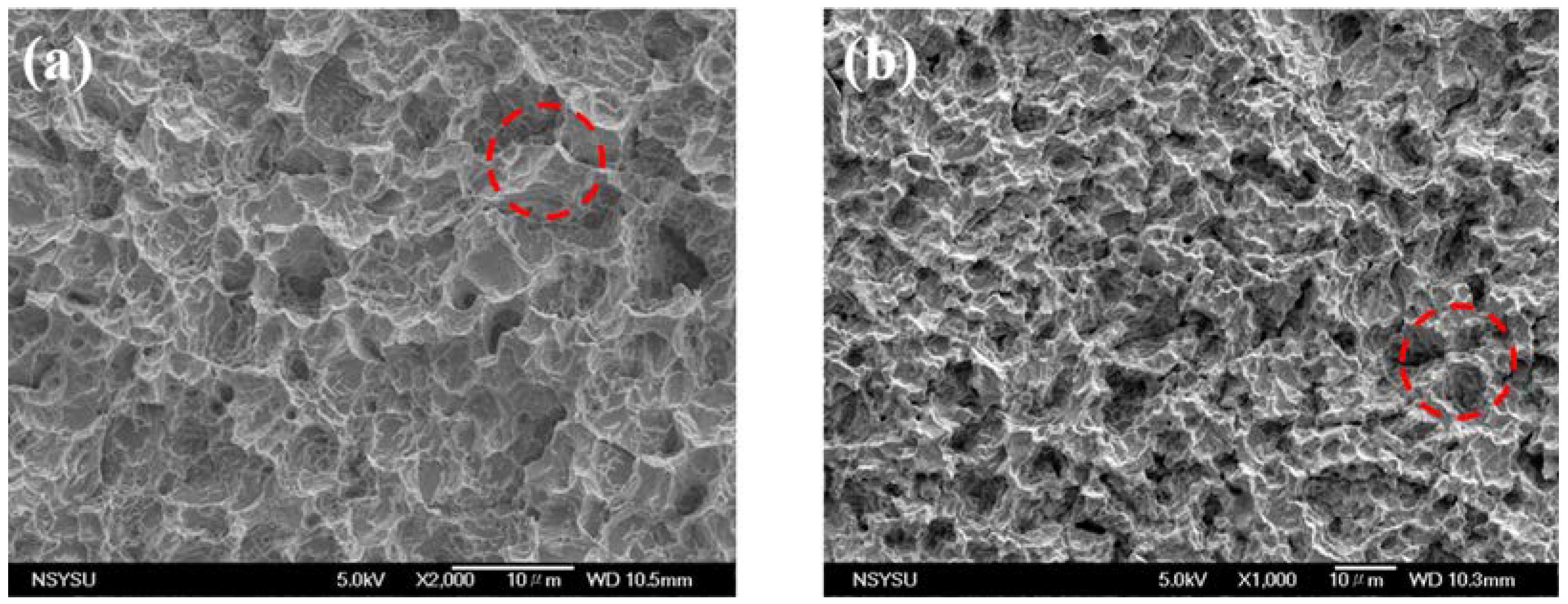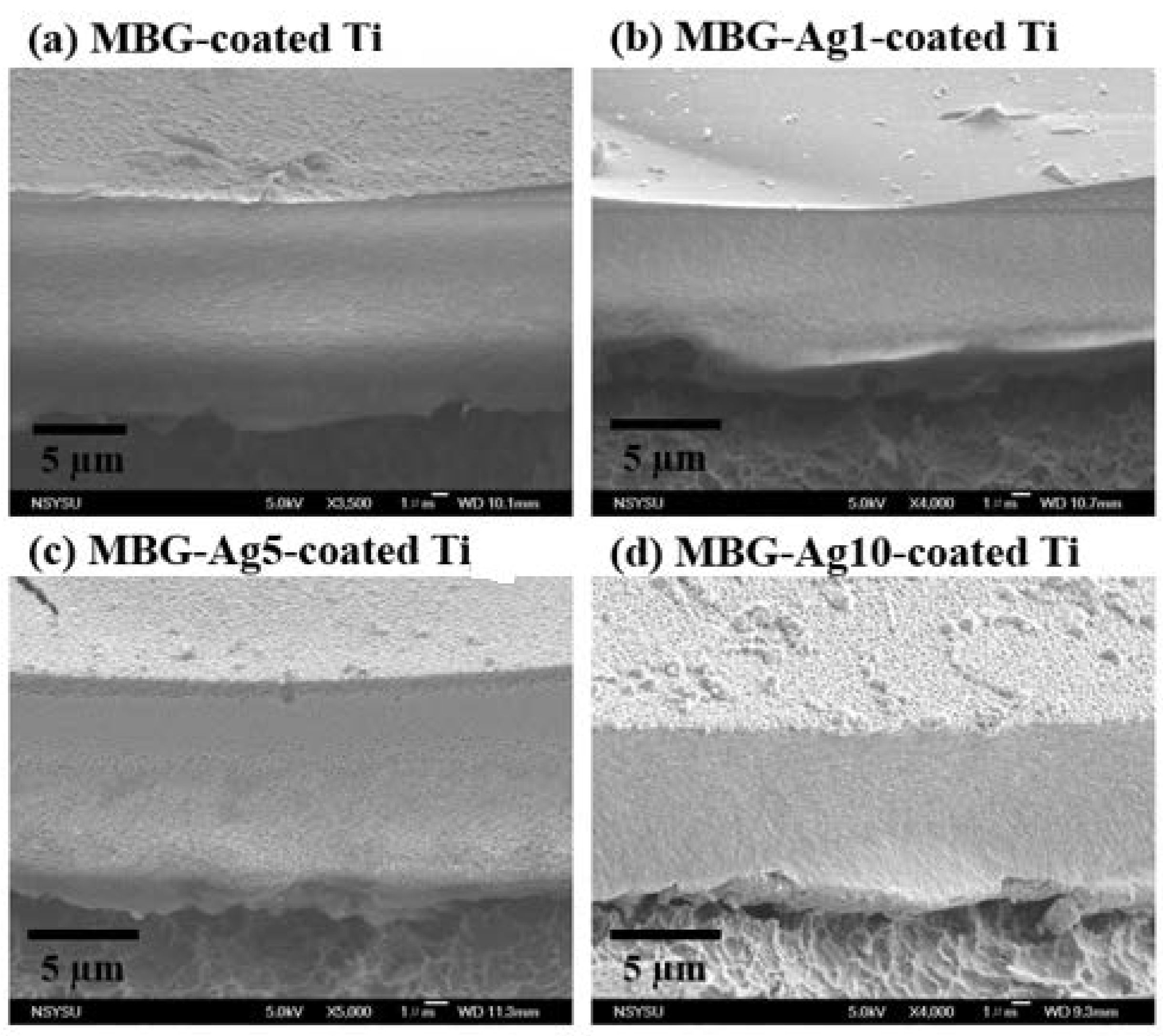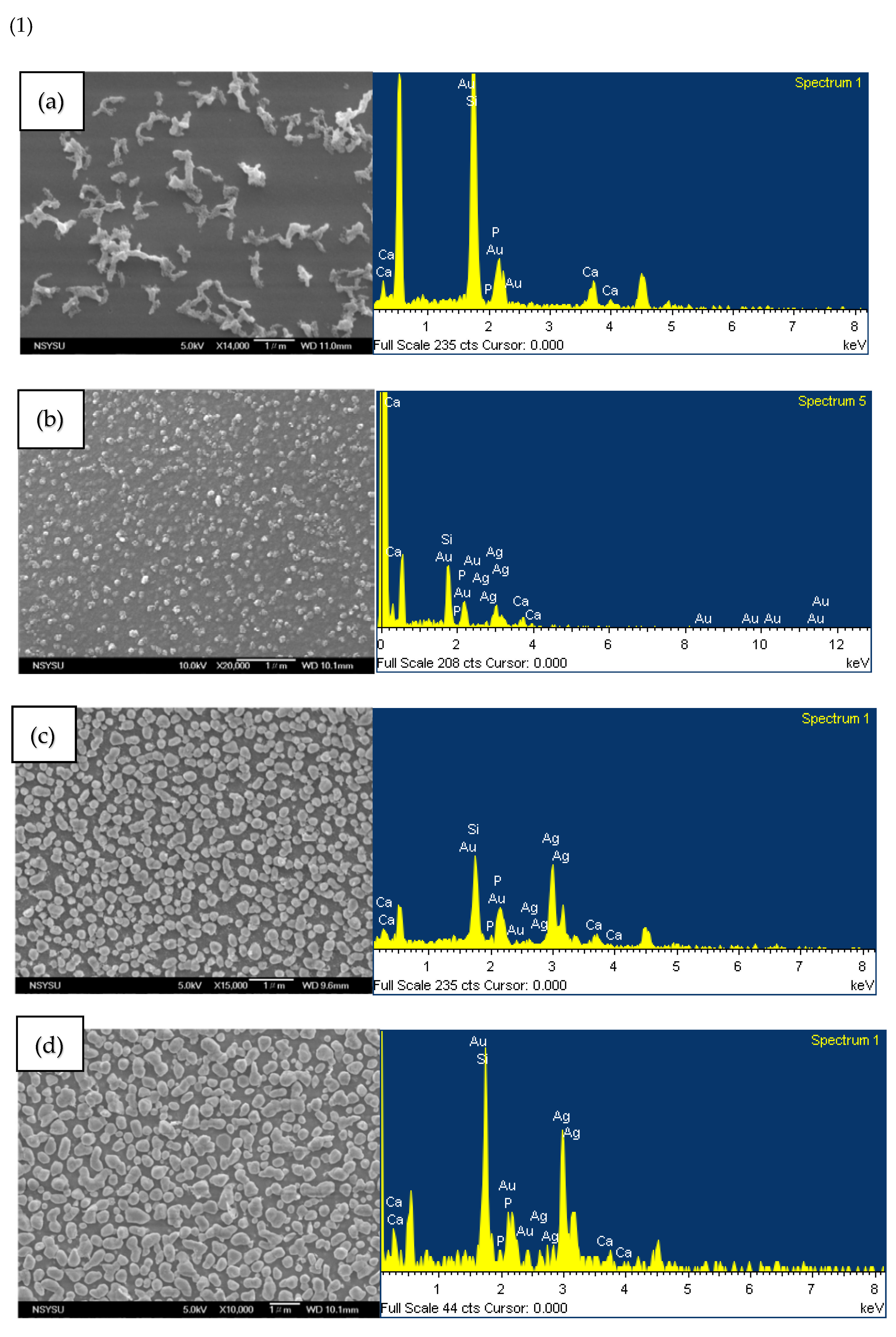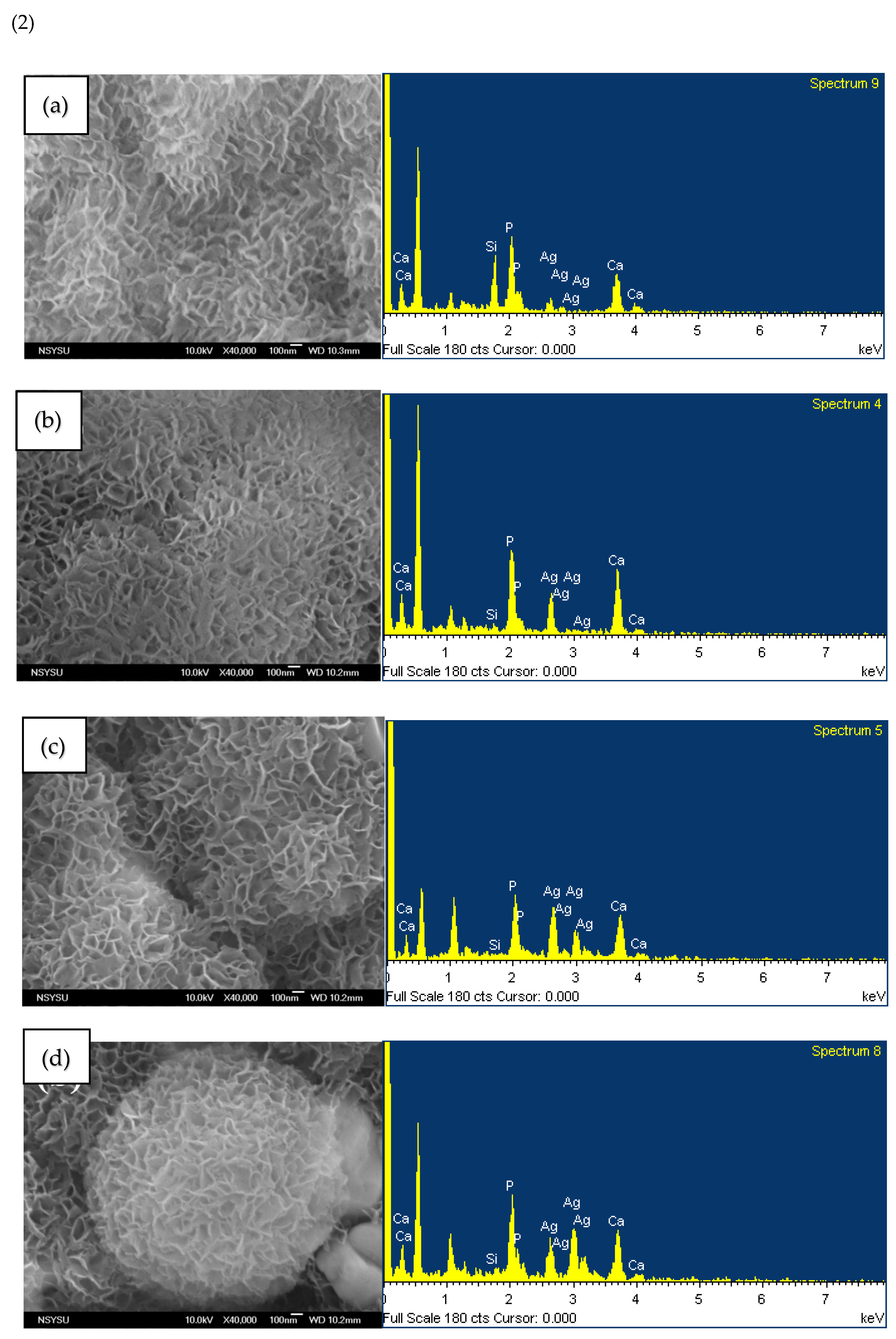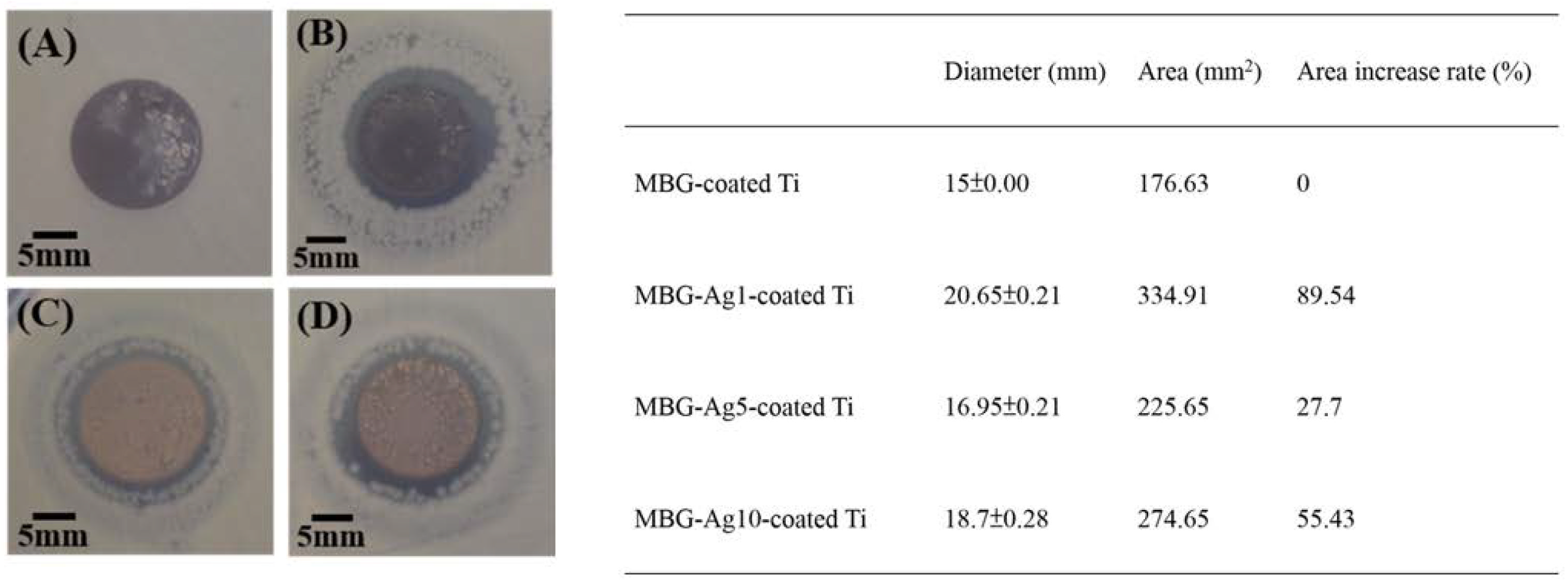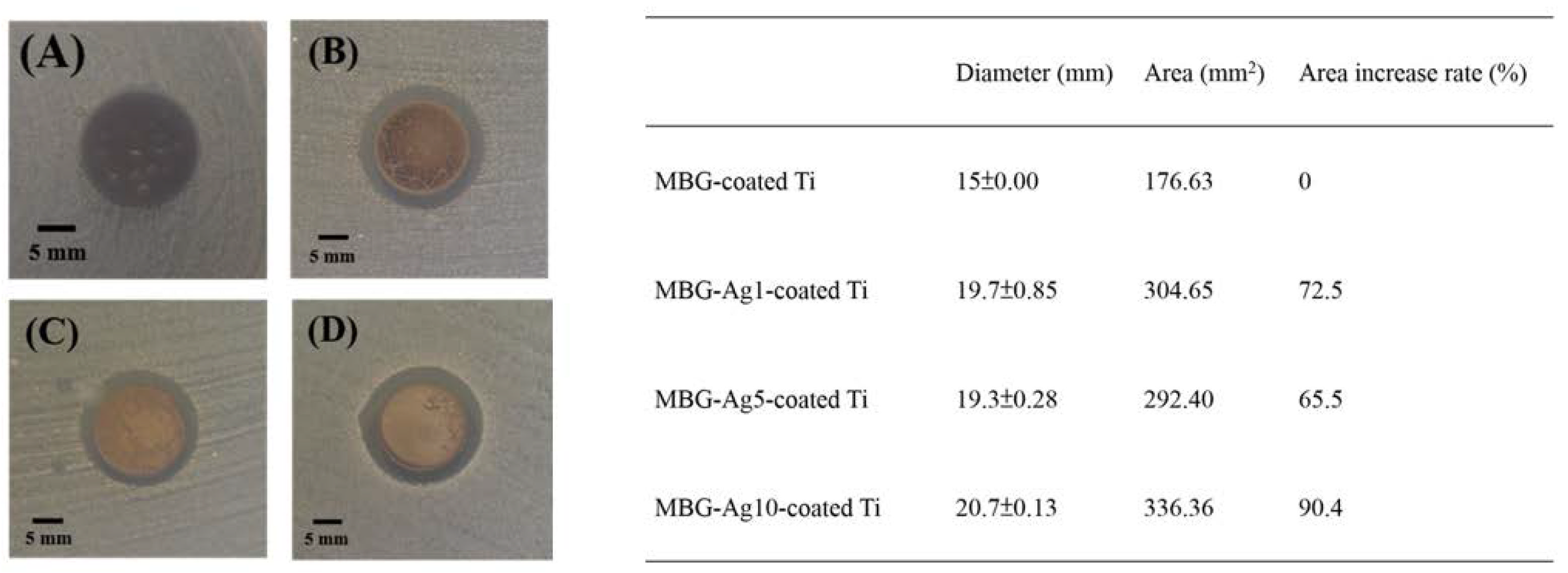1. Introduction
Dental implants have become a standard and predictable therapy for providing adequate support for the replacement of missing teeth. A success rate of 76–84% in patients with risk factors was reported in a study by F. De Angelis [
1]. Nevertheless, increasing evidence of early implant surgical failure and late peri-implantitis has been reported, representing two major frequent complications that can lead to implant loss [
2].
Peri-implantitis is a pathological symptom that develops from peri-implant mucositis. In the early stages, bacteria invade and adhere to the surface of the implant from the junction of the crown and soft tissue. A biofilm formation normally involves three steps, the first of which requires the adhesion and attachment of the initial colonizers to the surface. The initial colonizing bacteria are streptococci and actinomycetes. The continuous proliferation of bacteria forms a biofilm. After the biofilm matures, the bacteria begin to secrete endotoxins, which trigger an inflammatory response in the surrounding tissue of the implant. At this stage, it is reversible peri-implant mucositis. If the bacteria continue to infect, the alveolar bone is lost. This is termed as peri-implantitis [
3]. The prevalence of peri-implantitis depends on risk factors such as a lack of good oral hygiene, long-term smoking, periodontal disease, or diabetes. In patients with risk factors, the prevalence rate is as high as 53.5%, with the recurrence rate being extremely high [
4]. Therefore, it is important to control the growth and attachment of the initial colonizer on the implant surface, thereby disrupting the subsequent pathogenic bacterial attachment and preventing bacterial biofilm formation on the implant surface.
Brånemark proposed intraosseous implantation to be the functional and structural dependence of bone and load-bearing implants, a concept later called “osseointegration” [
5]. Consequently, titanium and its alloys were widely used as implants in the dental field [
6]. The commercial pure titanium used in dental implants is an α-phase titanium metal. Commercial pure titanium approved by ASTM is divided into four grades: grade I, grade II, grade III, and grade IV, according to the content of trace elements. Grade IV is the titanium having the best elastic modulus and tensile strength and is widely used for dental implants. Dental implants often undergo surface modification to improve surface roughness and accelerate osseointegration.
Sandblasted/large-grit/acid-etched (SLA) treatment has been widely applied to modify surfaces for dental titanium implants. According to the literature, SLA surfaces are hydrophobic, resulting in diminished cell adhesion [
7]. Therefore, next-generation Ti-based implant coatings should exhibit multifunctionality such as enhanced hydrophilicity and antibacterial and osteogenic activity.
Xiaotong Ye et al. used mesoporous bioactive glass (MBG) composed of 80Si–15Ca–5P as the film material and prepared films by spin coating on Ti6Al4V scaffolds to improve their biological activity [
8]. The MBG film scaffolds were immersed in a simulated body fluid (SBF) for 7 days, and the subsequent results showed well-produced hydroxyapatite, confirming that the addition of MBG film helped to increase its bioaffinity. Samuel F. Robertson et al. used the sol–gel technique to coat the hydroxyapatite composite strontium material (Sr/HA) on a Ti-6Al-4V substrate and provided a layer of titanium dioxide nanotubes as an intermediate layer to improve the adhesion of the film layer [
9]. The Sr/HA film exhibited good cell viability in the MTT assay.
In related research, antibiotics have been used as an antibacterial source for implants, e.g., Wongsuwan et al. used liposomes to coat minocycline, which was then coated on the surface of a titanium substrate using a sprayer [
10]. F. Jahanmard et al. loaded rifampicin and vancomycin into polylactic-co-glycolic acid (PLGA) nanofibers for electrospinning and coating titanium implants [
11]. Although antibiotics possess excellent antibacterial abilities, the abuse or misuse of antibiotics can easily lead to the emergence of drug-resistant bacteria. Antibacterial metal ions have been used as coatings, among which nano-silver particles exhibit the best antibacterial effect. Physical vapor deposition [
12] or chemical chelation methods [
13] can impart antibacterial properties to the surface of a titanium substrate but cannot provide a slow-release effect or improve plant biocompatibility.
MBGs have been developed as a new class of bioactive materials and present an ordered mesoporous channel structure, which exhibits superior bioactivity compared to conventional bioactive glasses (BGs). In our recent study, silver-containing MBG was successfully synthesized to confer antibacterial activity to these bioactive materials.
The aim of this study was to apply a silver-containing MBG coating by spin coating on the surfaces of SLA Ti alloy scaffolds to improve their surface bioactivity and antibacterial activity. The surface morphology and chemical composition of the coating and their effects on the bioactivity and antibacterial activity of the coating were investigated. In addition, the wettability and adhesion strength of the MBG–coated SLA titanium were evaluated.
3. Discussion
The contact angle measurement results show the surfaces of MBG–Ag–coated Ti to have good wettability and are hydrophilic. This experimental result is consistent with the literature showing that osteocytes are easily attached to hydrophilic surfaces. Therefore, in the material selection of the implant, a hydrophilic surface should be preferred over a hydrophobic surface to improve the overall osseointegration efficiency [
17,
18]. There is also evidence that a highly hydrophilic surface affects the amount and variation of adsorbed proteins on bioactive surfaces, thus inhibiting bacterial attachment [
19,
20]. The silver-containing mesoporous bioactive glass film prepared in this study had a good hydrophilic surface and the appropriate properties for implants in guiding the early phase of cell adhesion, spreading, and titanium colonization.
Based on the adhesion strength experimental results, the adhesion strength of the film decreased with increasing silver content. Therefore, it was speculated that when the aggregation degree of nano silver particles was high, the roughness of the interface between the film and titanium substrate increased, resulting in the adhesion strength between the test tape and film being greater than that between the film and titanium substrate. The current acceptable film adhesion strength in the market is level 5B of the Burger’s test. Thus, the adhesion strength of the MBG–coated Ti and MBG–Ag1–coated Ti prepared in this study met the market demand.
From the FTIR analysis results in this study, the MBG–coated Ti and MBG–Ag–coated Ti have Si-O-Si and P-O-P asymmetric stretching vibration absorption peaks at 1000 cm
−1 and Ti-O-Si stretching vibration peaks at 800–900 cm
−1, conforming with the results described in the previous literature [
21,
22,
23]. When the bioactive glass formed a film layer on the titanium substrate, silicon oxide interacted to form a network structure, and the overall structure was not changed by adding silver. This result was similar to those of the previous studies on bioactive glass powders. In addition, the Ti-O-Si bond confirmed that the SiO
2 in the MBG-coated Ti and TiO
2 of the titanium substrate were chemically bonded to each other. This result indicated that the metal oxide layer could be used as an intermediate layer for binding the glass ceramic and metal substrate, echoing the chemical bonding theory proposed by Kautz in 1936 [
24].
To identify the spherical particles on the surface of the silver-containing mesoporous bioactive glass film, EDS was used to analyze the spherical particle and nanoparticle aggregates by single-point analysis. The results showed that the non-granular aggregates were mainly composed of Si and their atomic weight ratio was 43.33 at%. The spherical particle aggregates were mainly composed of Ag and their atomic weight ratio was 90.43 at%. This indicated the spherical particles on the surface of MBG–Ag–coated Ti to be nano-silver particles. Qualitative and semi-quantitative analyses of all groups were performed by EDS surface analysis. These EDS surface analysis results were compared with the SEM images, and it was seen that the nano-silver particles deposited on the surface were a major factor affecting the elemental composition. When the silver content was increased to more than 5 mol%, the atomic number ratio of silver was higher than that of silicon. It was speculated that the nano-silver particles aggregated into micron-sized particles, covering the silicate substrate and making the silicon undetectable by EDS. From the above results, it was confirmed that with the increase in silver content, many nano-silver particles appeared on the surface of MBG–Ag–coated Ti, and the particle size increased from 0.14 to 0.53 μm. After the qualitative and semi-quantitative analysis by EDS, it was determined that the matrix of the film was silicate, whereas calcium, phosphorus, and silver were dispersed and attached to the network structure of silicon oxide.
After comparing
Figure 3(1),
Figure 3(2), and the JCPDS database with the Jade 6 software, it was found that each group in
Figure 3(2) had more crystal planes (002) and hydroxyapatite (211) at the angles of 2θ = 25.8° and 31.7° (JCPDS no. 73-0293), indicating HAp crystallization on the surface of the film that is not affected by the increase in silver composition. It was concluded from the above experimental results that MBG–Ag–coated Ti has the ability to effectively induce HAp crystallization after immersion in SBF for 24 h, and the HAp morphology is not affected by the amount of silver. Furthermore, previous studies found that after the powder was immersed in SBF for 24 h, the HAp crystals on the surface exhibited a flourishing growth state [
22]. Therefore, the thickness of the MBG–Ag–coated Ti film was only 6–18 μm, having potentially the same mineralization ability and biocompatibility as the MBG–Ag powder. Compared with the film thickness prepared by the vapor deposition method, since it uses a target to release the ionic material, it can prepare the film as thin as 600 nm [
25]. The disadvantage of the vapor deposition method is that the target material is difficult to develop, and its composition is single. Although the MBG–Ag–coated Ti film in this study prepared by the sol–gel technique is not as thick as nanometers by the vapor deposition method, it still has a great advantage in the preparation of multifunctional dental implant film because of the controllable chemical composition of the film. According to the research results of C. Cherde et al., when the film thickness on the implant increased, its adhesion strength decreased. When the film thickness on the implant was less than 50 μm, the film had strong adhesion to the substrate and produces fewer cracks, while when the film thickness on the implant was greater than 50 μm, obvious delamination and peeling from the substrate were observed [
26]. Therefore, the thickness of the MBG–Ag–coated Ti film in this study was controlled to be less than 20 µm, which could avoid cracks and peeling due to too thick film.
Partially oxidized nano-silver particles prepared in an oxygen environment have more significant antibacterial properties than reduced nano-silver particles. At the same time, nano-silver particles easily release silver ions in an aerobic environment, and silver ions themselves also have bacteriostatic ability. Many literatures discuss the antibacterial mechanisms of nano-silver particles, three of which are more widely accepted: (1) Silver ions enter bacterial cells and combine with thiol bonds on proteins, resulting in changes in protein activity and interference with downstream biochemical reactions, or affecting protein maturation. If the important proteins on the electron respiration transport chain on the bacterial cell membrane are destroyed, it will hinder the electron transfer on the respiratory chain, resulting in the change of the hydrogen ion concentration gradient and affecting the efficiency of the ATP synthesis reaction [
27]. (2) Ag ions and nano-silver particles induce the generation of reactive oxygen species (ROS) in cells, resulting in oxidative stress and apoptosis. ROS contains single oxygen (O
2), superoxide (O
2−), hydrogen peroxide (H
2O
2), and hydroxyl radical (OH·). These substances are inherently present inside and outside cells that perform aerobic respiration, but they are harmful to proteins and DNA. Endogenous reducing agents of bacterial cells, such as NADPH, NADH pools, carotene, ascorbic acid, α-tocopherol, and glutathione (GSH), can deal with these harmful substances. ROS will inhibit the action of glutathione reductase and reduce the amount of glutathione in cells. When the amount of ROS exceeds the load of the endogenous reducing agent glutathione, oxidative stress will form, resulting in protein destruction and deactivation or changes in the balance of important intracellular substances, interfering with normal cell function execution [
27,
28]. (3) Nano-silver particles directly cause the destruction of bacterial outer membrane, cell wall, and cell membrane. Small holes appear on the bacterial cell wall treated with nano-silver particles, and the appearance of the bacteria is shrinking, deformed, or broken. In addition, nano-silver particles also accumulate on the cell membrane and affect the permeability of materials inside and outside the membrane, resulting in the leakage of materials inside the cell [
29]. The inhibition zone results showed MBG–Ag1–coated Ti to have the best antibacterial effect on
Aggregatibacter actinomycetemcomitans. From the results of XPS analysis, it was observed that MBG–Ag1–coated Ti had a high proportion of silver ions (50.83 at%), while the proportion of silver ions in both MBG–Ag5–coated Ti and MBG–Ag10–coated Ti were relatively low, thereby inferring that MBG-Ag1-coated Ti released more silver ions than MBG–Ag5–coated Ti and MBG–Ag10–coated Ti. Therefore, MBG–Ag1–coated Ti showed a larger diameter and area of inhibition zone in the disk diffusion results. It was also speculated that the infection causing bacteria in the early stage of peri-implantitis (
Aggregatibacter actinomycetemcomitans) were more susceptible to death due to the influence of silver ions than silver atoms. Its antibacterial mechanism is more in line with the first and second antibacterial mechanisms of nano-silver particles listed above. Comparing the results of the disk diffusion test analysis against
Streptococcus mutans, it was found that MBG–Ag10–coated Ti, having the best antibacterial ability, exhibited the highest silver diffraction peak in the XRD analysis, and the film surface had large nano-silver particles. Subsequently, it could be speculated that the nano-silver particles were more likely to destroy
Streptococcus mutans. Its antibacterial mechanism is more in line with the third antibacterial mechanisms of nano-silver particles listed above.
4. Materials and Methods
4.1. Material Preparation
80SiO
2–15CaO–5P
2O
5 mesoporous bioactive glass precursor solutions containing 1, 5, and 10 mol% of silver were prepared using the sol–gel technique [
30]. The synthetic process included the use of alcohol as a solvent, 2 M nitric acid as an acid-base regulator, nonionic surfactant Pluronic F127 (EO
106-PO
70-EO
106) (CRODA, Montigny-Le-Bretonneux, France) as a templated surfactant, tetraethyl orthosilicate (C
8H
20O
4Si, TEOS) (Thermo scientific, Dreieich, Germany) as a structural scaffold and silicon precursor; calcium nitrate tetrahydrate (Ca(NO
3)2.4H
2O) (Showa, Tokyo, Japan), triethyl phosphate (C
6H
15O
4P, TEP) (Alfa Aesar, Boston, MA, USA), and silver nitrate (AgNO
3) (Showa, Tokyo, Japan) were used as the precursors of calcium, phosphorus, and silver, respectively. All the components were stirred at room temperature for 24 h in the dark to form silver-containing mesoporous bioactive glass precursor solutions (MBG–Ag).
4.2. Titanium Implant Specimen Preparation
In this study, Grade IV pure titanium discs with SLA surfaces having a diameter and thickness of 15 and 3 mm, respectively, were used as the specimens. The SLA surfaces were prepared by sandblasting the turned surfaces with large-grit alumina particles in the size range of 250–500 µm. Subsequently, the surfaces were chemically treated with sulfuric and hydrochloric acids [
31]. Topographically, the SLA surfaces achieved a roughness with large dips, sharp edges, and small micro pits, increasing their contact surface with the subsequent formation of the antibacterial film and exhibiting efficient osseointegration when implanted in vivo [
32,
33].
The titanium implant specimens were pretreated by immersing them in acetone and cleaning them with an ultrasonic shaker for 10 min to remove the impurities and dust on their surfaces. Next, they were immersed in 75% alcohol, shaken, and sterilized for 10 min. The samples were then immersed in deionized water, shaken, cleaned for 10 min, and finally dried to obtain blank specimens, hereafter referred to as SLA Ti. Before spin coating the MBG–Ag, the pretreated SLA Ti needed to be oxidized at 650 °C for 1 h to obtain specimens of the control group, hereinafter referred to as oxide Ti.
Next, 100 μL of the precursor solution (MBG–Ag) was added dropwise to the center of each SLA Ti specimen, and the parameters of the spin coater (SP102, Olink Technology Co., Ltd., New Taipei City, Taiwan) were set at 500 rpm for 60 s for film coating. The coated specimens were placed in a fume hood to age for 24 h, then moved to a 60 °C oven to dry for 24 h, and finally set at a heating rate and temperature of 10 °C/min and 500 °C, respectively, for the heat treatment to remove the impurities and template, thereby obtaining silver-containing mesoporous bioactive glass films on the coated specimens. These specimens with a silver composition of 1 mol%, 5 mol%, and 10 mol% are hereafter referred to as MBG–Ag1–coated Ti, MBG–Ag5–coated Ti, and MBG–Ag10–-coated Ti. A mesoporous bioactive glass film without silver was used as the control group, hereafter referred to as MBG–coated Ti.
4.3. Properties of Silver-Containing Mesoporous Bioactive Glass Film
4.3.1. Wettability Analysis of Silver-Containing Mesoporous Bioactive Glass Film
A contact angle measurement system (DSA100, KRÜSS Scientific, Hamburg, Germany) was used to measure the hydrophilicity and hydrophobicity of the film surfaces. The sessile drop method was employed, which estimates the wettability of a local area on a solid surface and directly measures the contact angle between the droplet baseline and liquid/solid-interface tangent at the liquid/solid/gas-triple contact point. Using distilled water as the test liquid, the specimens were washed with distilled water and then dried for 24 h in an environment with an experimental temperature of 20 ± 5 °C and relative humidity of 50 ± 10%. The contact angles on the surface of the specimens were then measured. Five different surface contact angles were measured and averaged for each sample.
The surface wettability of MBG–Ag1–coated Ti, MBG–Ag5–coated Ti, and MBG–Ag10–coated Ti was measured, and MBG–coated Ti and SLA Ti were used as the control groups.
4.3.2. Adhesion Strength Analysis of Silver-Containing Mesoporous Bioactive Glass Film
ASTM D–3359 “Standard Test Method for Adhesion Measurement by Tape” (Burger test) was used to evaluate the adhesion strength of the silver-containing mesoporous bioactive glass film on the titanium substrate. The Burger’s test was divided into methods A and B according to the thickness of the films. In this study, the thickness of the films was approximately 5–15 µm. Therefore, the B method was used to determine the adhesion strength of the films. Method B used a diamond knife to scribe six lines of the prescribed pattern on the silver-containing mesoporous bioactive glass films and reach the SLA Ti substrate, wherein each line was tested at an interval of 1 mm. A 3M–600 tape was placed on the prescribed pattern using an eraser to compress the tape. After ~60 s, the tape was swiftly pulled away from the surface of the films at an angle of 180°. The test results were obtained using a USB digital microscope (Model:UM05-CAM, Vitiny, Kaohsiung, Taiwan).
4.4. Characterization of Silver-Containing Mesoporous Bioactive Glass Film
4.4.1. X-ray Diffraction (XRD) Measurement
The crystallographic properties of the silver-containing mesoporous bioactive glass films were determined by XRD scanning and analysis. The XRD instrument was a Shimadzu XRD 6000 (Tokyo, Japan) with a Cu-Kα radiation (λ = 1.5432 Å), voltage of 30 kV, current of 20 mA, scan range 2θ of 10°–80°, and step size of 4°/min. The data obtained from the scans were analyzed using the Jade 6.5 XRD software (ICDD, Newtown Square, PA, USA), and the crystal structures were confirmed using the Joint Committee on Powder Diffraction Standards Card (JCPDS) database.
4.4.2. Fourier Transform Infrared Spectroscopy (FTIR) Confirmation
From the FTIR absorption spectra, both the structure of molecules and nature of vibrational bonds or rotational bonds were determined, and the presence and content of compounds were also identified and analyzed.
In this study, an FTIR instrument (Nicolet 6700, Thermo Fisher Scientific, Waltham, MA, USA) was used to conduct the experiments, and was based on the total reflection attenuation in the infrared light spectrum with a wavenumber range of 2000–650 cm−1 to analyze the functional groups of the silver-containing mesoporous bioactive glass film.
4.4.3. Scanning Electron Microscopy (SEM) and Energy Dispersion Spectroscopy (EDS) Observation
In this study, SEM was used to observe the surface morphology of the MBG–Ag–coated Ti film, and the corresponding elemental composition was analyzed via EDS. A scanning electron microscope (SEM) (JSM-6330TF, JEOL, Tokyo, Japan) was used to record the images using synchronous acquisition. Energy dispersive X-ray spectroscopy (EDS) (x-stream, INCA, Oxford, UK) equipped with SEM was used to identify the constituent elements of the silver-containing mesoporous bioactive glass film.
In the pretreatment step, the titanium implant specimens were dried for 3–5 days to completely evaporate the water in the specimens, and then gold-plated for 300 s. The surface morphology and cross-sectional shape of the specimens were observed, and their corresponding film thickness (µm) was calculated from the SEM images. Three points were measured for each specimen, and a total of 3–4 specimens were used to calculate the average value.
4.4.4. X-ray Photoelectron Spectroscopy (XPS) Measurement
In this study, an XPS instrument (5000 Versaprobe, ULVAC-PHI, Inc., Kanagawa, Japan) was used to detect the ionic and atomic state ratios of Ag on the surface of the silver-containing mesoporous bioactive glass film, and the spectrum was divided using the CasaXPS software to confirm the valence state of Ag as the antibacterial source.
4.5. In Vitro Bioactivity Assay of Silver-Containing Mesoporous Bioactive Glass Film
In this study, silver-containing mesoporous bioactive glass films were immersed in an SBF for an in vitro biological activity test. Hench et al. observed that an SiO
2 and calcium phosphate layer formed on the surface of the bioactive glass by itself, and ascertained that thus, it could be combined with human bone tissues [
34]. The titanium implant specimens were immersed in SBF at 37 °C (simulating human body temperature) and soaked for 24 h. After that, they were removed, rinsed with sterile phosphate-buffered saline (PBS), and dried. The apatite crystals formed on the surface of the titanium implant specimens were identified via XRD.
4.6. Bacterial Incubation and Antibacterial Activity of Silver-Containing Mesoporous Bioactive Glass Film
4.6.1. Bacterial Incubation
In this study, Aggregatibacter actinomycetemcomitans (American Type Culture Collection, ATCC 29523) and Streptococcus mutans (American Type Culture Collection, ATCC 25175), purchased from the Bioresource Collection and Research Center (BCRC, Hsinchu, Taiwan), were inoculated into a brain heart infusion (BHI) broth and agar. The growth conditions for Aggregatibacter actinomycetemcomitans included incubation at 37 °C ± 2.5 °C under 5% CO2 for 18–24 h. The growth conditions of Streptococcus mutans included incubation at 37 °C ± 2.5 °C under an aerobic atmosphere for 24–48 h. Following the instructions of ATCC, the inoculation of Aggregatibacter actinomycetemcomitans and Streptococcus mutans exhibited excellent activity after opening the freeze-dried tube, mixing the broth medium uniformly with glycerin at a ratio of 85:15, and storing in a refrigerator at −80 °C. The strains were active in the BHI broth or agar at 37 °C for 24–48 h against 3–5 generations using the streaking method.
4.6.2. Disk Diffusion Test
In this study, a disk diffusion test was used to determine the antibacterial effect of the silver-containing mesoporous bioactive glass films with different silver contents on Aggregatibacter actinomycetemcomitans and Streptococcus mutans, and a bioactive glass film without silver (MBG-coated Ti) was used as the control group.
First, MBG–coated Ti, MBG–Ag1–coated Ti, MBG–Ag5–coated Ti, and MBG–Ag10–coated Ti were uniformly smeared on a solid medium with 10
7 CFU/mL bacteria. The solid medium was then adjusted to the appropriate incubation time and temperature according to the incubation conditions of the bacteria. After incubation, several areas of the specimens were observed. If there was a ring-shaped clean area around the specimens, it was the antibacterial zone, indicating that the specimens possessed antibacterial ability. Any densely grown bacteria around the specimens indicated that the specimens did not exhibit bacteriostatic ability. The experiment was repeated thrice, and the average diameter and area of the inhibition zone were calculated. The control group was used as the benchmark to calculate the increment rate of the inhibition zone area of the silver-containing mesoporous bioactive glass film using the following formula:
4.7. Statistical Analysis
Statistical analyses of the experimental results were performed using a one-way ANOVA. If p > 0.05, there was no significant difference between the groups. If p < 0.05, there was a significant difference between the groups. Therefore, in the figures, the symbol (*) represents the group with p < 0.05, while symbol (**) represents the group with p < 0.01.
